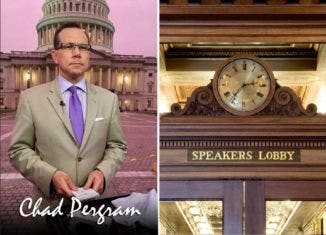Occupational Hazards
Congress can be hazardous to your health.
Especially if you’re a journalist.
Scrums of journalists crowding around lawmakers and other newsmakers are as much a part of the Capitol Hill beat as subcommittee markups and Senate filibusters. For Congressional reporters, everyone wants to crowd around a key committee chairman to get his thoughts on how to try to pry loose a piece of legislation. Maybe there’s a senator struggling with how to vote on a major bill – and their vote is pivotal to its passage or failure. Reporters want to glean a sense of which direction they’re leaning. Or maybe a key witness or celebrity appears at the Capitol.
It’s natural for a press gaggle to cluster around these folks. Trying to get the best shot. Snapping a telling photo. Wondering what the quote or soundbyte might be.
Politicians may emerge with bruised egos after a legislative defeat. Witnesses may suffer damaged reputations after a Congressman browbeats them at a brutal hearing.
But sometimes, it’s members of the Capitol Hill press corps who suffer the physical wounds.
Such was the case on Monday afternoon when House Oversight Committee Chairman Darrell Issa (R-CA) convened the first Congressional hearing that probed the lavish Las Vegas conference by the General Services Administration (GSA).
The GSA’s Jeff Neely is at the center of the inquiry. He runs the agency’s western region and organized the over-the-top Vegas soiree. And Neely informed Issa’s staff last week that he would invoke his Fifth Amendment rights against self-incrimination at the Oversight panel’s hearing.
After Issa walked over to shake Neely’s hand before the hearing, the star witness sat awkwardly at the witness table alongside GSA Inspector General Brian Miller and former GSA Administrator Martha Johnson. But he took the Fifth on five consecutive occasions when Issa tried to ask him basic questions. The questions ranged from whether he was still employed by the GSA or if he attended the Las Vegas conclave.
Issa then told he would excuse Neely from the witness table. However, the California Republican asked Neely to remain in the room for the duration of the hearing. Issa then indicated the hearing would resume after a sort recess and summoned Neely and his lawyer to a back room.
And that’s where the press came in.
Reporters darted out of the hearing room and into the corridor of the Rayburn House Office Building, wondering if Neely would bolt. TV crews, already milling around in the hallway, snapped to attention. They quickly tested microphones and flipped on lights, anticipating a manic departure. After all, Neely already tried to get out of attending the hearing. His attorney sent Issa a letter, indicating Neely thought it would be fruitless to fly across the country from San Francisco just to attend a hearing at which he would remain silent. Issa reminded Neely’s counsel that he had already accepted the committee’s subpoena and was expected to show up, even if he intended to invoke his Fifth Amendment right.
Moments passed. A few Oversight Committee staffers came and went through a passage leading to the rabbit warren of offices adjacent to the hearing room. But no Neely.
And then, Neely popped out of a door at the end of the deserted corridor.
The chase was on.
I held a cordless microphone and took off in full sprint down the abandoned hallway. My cameraman, the talented Eric Conner, immediately began to roll and joined the pursuit alongside crews from NBC and CNN. Something crashed well behind us. I figured a still photographer dropped a camera or a lens. The cacophony of whatever dropped echoed off the marble tiles.
We reached the elevator. Neely’s lawyer tried block the way. But I reminded him it was a public elevator in a public building. We boarded, continued shooting and peppered Neely with a couple of questions as we rode down one floor.
“No comment,” Neely responded curtly when I asked if he would invoke the Fifth at the second round of hearings before the House Transportation and Infrastructure Committee the next day.
The elevator emptied out and Neely and his attorney disappeared into the Rayburn garage.
I thought briefly of the recently-deceased Mike Wallace and how many people he bird-dogged through parking garages during his storied career on “60 Minutes.”
The optics for Neely couldn’t be worse. His credibility is already dubious. Here’s an embattled government employee, accused of throwing an outrageously expensive party at a posh Vegas casino who refuses to answer questions from lawmakers. Then, after the committee chairman excuses Neely, he scurries out a back door with reporters hot on his trail. This is probably not the video Jeff Neely wants running on a loop on cable news.
As a reporter involved in one of these scrums, you never exactly know what you captured on video until you watch it. So I ask Conner what he recorded and how it looked. He said it was good video. I apologized to him for bolting down the hall as soon as Neely materialized. Conner said it was no problem, noting he was right behind me and got it all on camera. Conner also pointed out that he kept up despite hauling a 30-pound camera on his shoulder.
The famous line about Ginger Rogers doing everything Fred Astaire did came to mind – except she did it backwards and in high heels.
We went back upstairs. And that’s when we discovered what the giant crash was.
There was Bill Yates, a 76-year-old soundman for CBS, propped up against the wall.
Most sound operators carry a bulbous, shotgun microphone, mounted atop a fish pole. That allows the sound person to extend the microphone into scrums from above or below, without having to be on top of the person reporters are interviewing. The microphone cables then run into a kit the sound operator fits around their waist. Another set of wires links the kit to the camera, held by another person.
When Neely emerged, Yates somehow became tangled in his wires and careened headlong onto the unforgiving, Rayburn floor. Yates cut his left wrist. A disturbing, softball-sized hematoma swelled from his left temple.
We quickly positioned Yates into chair and snared some paper towels for his wounds. Someone called the attending nurse in Rayburn. A bit later, DC Fire and Rescue wheeled out Yates to George Washington Hospital where he remained for several days with a torn kidney.
I’ve been in numerous newsmaker-reporter hordes on Capitol Hill over the years. But I’ve never seen someone sustain an injury like this. Injuries are rare. But they’re going to happen.
Late last year, FOX cameraman John Wallace sustained a cut when be bumped his head on the wall outside the House Agriculture Committee hearing room. Former New Jersey Governor and Senator Jon Corzine (D) testified about the monumental collapse of MF Global. A massive contingent of reporters and photographers followed Corzine out of the hearing room, who remained mum. Wallace banged his head on a spot on the corridor wall where it jutted out. He spilled a few drops of blood. But was fine.
During the fiscal crisis of September, 2008, a freelance photographer from NBC quickly whipped around when we were standing in the Capitol Rotunda. The battery affixed to the back of the camera clipped me on the side of the head. It dropping me to the ground faster than a Raffi Torres body check. I was fine, but a bit groggy. I’m confident I sustained a mild concussion from that blow, feeling spacey for a few days afterwards.
I was certain someone in a clutch of reporters chasing former Rep. David Wu (D-OR) down the House steps amid his purported sex scandal last summer was going to twist an ankle or tear an ACL. Thankfully, no one did. To avoid the scribes, Wu quickly escaped the press, escorted into a car driven by Rep. Mike Honda (D-CA). They then sped away.
And for the record, Honda drives a Toyota.
Reporters are always going to pursue newsmakers. It’s an inherit risk of the job – especially on Capitol Hill. And fortunately, no one gets hurt very often. At least no more frequently than those who work here on Capitol Hill. I’ve seen many female Congressional staffers wind up in the nurse’s station with a busted ankle after tripping down the stairs in their high heels.
But anyone of us could take a tumble and crash to the floor like Yates did early this week. It’s an occupational hazard.
And I wish Bill Yates a speedy recovery.

